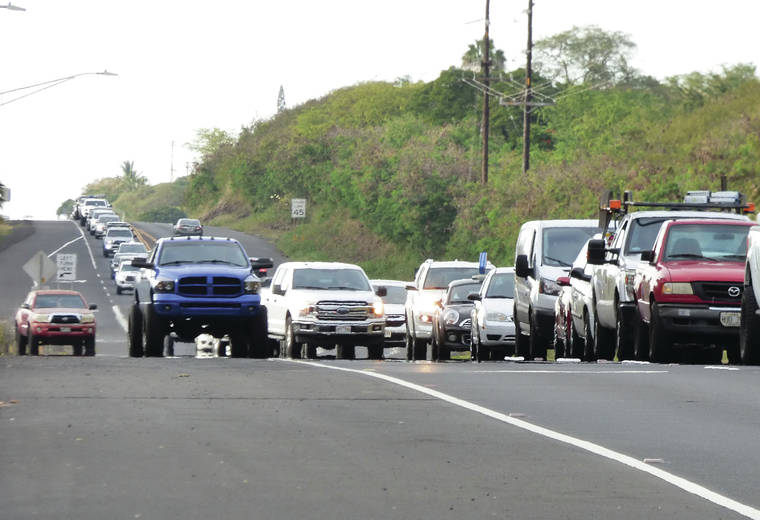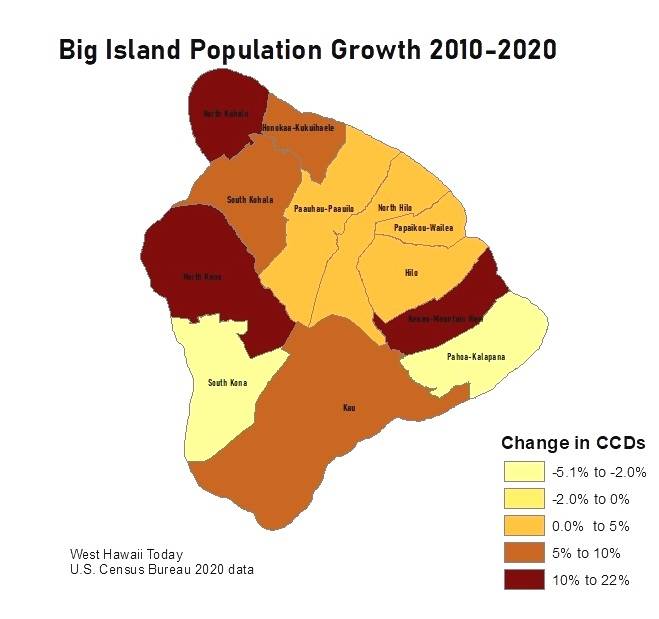Population shifts across the island could mean big changes to County Council districts next year, with West Hawaii population increases likely to outweigh population changes in most of East Hawaii.
A West Hawaii Today analysis of population data released by the U.S. Census Bureau earlier this month shows the 15,500 additional residents were concentrated mostly in West Hawaii and the Keaau-Mountain View Census County Divisions, or CCDs. At the same time, population was lost in the South Kona and Pahoa-Kalapana CCDs.
The 12 CCDs are different from the nine council districts themselves; the census provides population data down to the census block level, while the CCDs are a way to take a broader look at population data. There are thousands of individu al census blocks on the island.
The council districts are created every 10 years by a county Redistricting Commission based on the latest census numbers. The commission is expected to meet shortly after Labor Day, said county Elections Division Administrator Pat Nakamoto, who’s staffing the meetings.
North Kona Councilman Holeka Inaba is looking forward to the meetings.
“I know our commissioners have been eager to get the census numbers,” Inaba said Friday. “Since we have great representation on this commission, I trust the kuleana will be carried out in a sensible way.”
During the redistricting following the 2010 census, the commission created two districts for fast-growing Puna, trimming one of Hilo’s three districts to accommodate the change and significantly changed West Hawaii’s political landscape by creating a Ka’u/South Kona district, a Kona district, North Kona District and Kohala District.
The latest data shows the two CCDs shared by Puna Councilman Matt Kanealii-Kleinfelder and Councilwoman Ashley Kierkiewicz have both the highest growth and lowest growth on the island. The census splits the area along an east to west line, with the southern Pahoa-Kalapana CCD losing 566 people for a 5.1 % population decrease, while the northern Keaau-Mountain View CCD gained 6,944 people, a 20.3% increase. The two council members split the districts more along a north-south line.
On the west side of the island, North Kona and North and South Kohala were the next largest gainers, at 14.4%, 10.4% and 9.5% increases respectively. The three districts combined added 7,778 people, half the 15,550 added to the entire island.
The population loss in Pahoa-Kalapana CCD dramatically illustrates the effect of the 2018 volcanic eruption that covered 6,000 acres and destroyed 700 structures, including 200 homes, displacing about 3,000 people.
But there’s more to the apparent population loss than just the impact of Kilauea Volcano, said Shannon Matson, a Hawaiian Acres resident who testified to the state Reapportionment Commission on Thursday.
Matson said she posed a question on the Hawaiian Acres Facebook page asking how many people had filled out a census form or been contacted by census workers. She said at least 100 people responded that they didn’t believe they’d been accurately counted. Matson said the area has more than 70 miles of unpaved roads, no mail delivery, limited internet and there’s a one-year wait for a post office box.
“On the Big Island, we have significant hindrances to an accurate count,” Matson said.
Add in the coronavirus pandemic, which didn’t make the Census Bureau’s job easy. The agency missed several deadlines getting the numbers to the state so they could set boundaries in time for candidate qualifying.
Still, said Acting Director Ron Jarmin, the bureau stands by its data.
“We have produced the reliable and usable statistics that we and the public expect,” Jarmin said at an Aug. 12 press conference. “While no census is perfect, we are confident that today’s redistricting results meet our high data-quality standards.”
Kona Councilwoman Rebecca Villegas said she plans to take a good look at the figures.
“I’m excited to dig deeper, learn more and identify the opportunities these new numbers mean for an increase in available resources and equitable allocation in our community,” she said Friday.
Inaba agreed.
“As we know, our tax revenue is already sourced heavily from West Hawaii,” he said. “Moving forward, I think it’s important that every district get their fair share of resources.”


